Has the flavoured gin bubble finally burst?
From a peak a few years ago, the popularity of flavoured gin looks like it has waned. Producers and insiders assess how to keep consumers interested in a segment that once flew high.

*This feature was originally published in the December 2024 issue of The Spirits Business magazine.
It wasn’t long ago that flavours could do no wrong as consumers flocked to gins for their creative ingredients, in some cases, colours (like pink), and a seemingly endless conveyor belt of new tastes. But could the rise of flavoured gin have been fleeting? As is the nature with any trend, eventually fatigue sets in, and as decline comes for the segment, it’s time to look at whether flavoured gins have staying power.
When premium gin volumes in the UK soared from 2018 to 2021, flavoured variants were seen as a driving force – and the Covid-19-induced increase in disposable income became a big plus too. However, since then, there’s been a drop-off for premium gin, and flavours are bearing the brunt of that, with gin drinkers shifting towards traditional formats. IWSR Drinks Market Analysis data shows that flavoured gin accounted for 25% of total gin volumes in the UK in 2023. The category experienced a major drop in the UK between 2021 and 2023 – traditional gin volumes declined by 17%, and flavoured gin plunged by more than double that amount, at 40%. In the US, where the juniper-forward spirit is still somewhat emerging, flavoured gin accounted for 2% of total gin volumes in 2023. Again, the category saw a volume decrease between 2021 and 2023, when traditional gin was down by 4%, and flavoured gin by a whopping 37%.
Of the flavour plummet, Patrick Fisher, senior research analyst, IWSR, says: “Sales of flavoured gins are now declining more than twice as fast as those of traditional gins. Volumes have fallen across all price tiers, with losses for both mainstream and premium brands. Imported brands have seen sales decline more rapidly than domestic products.”
Consumers are moving on
Fisher notes that gin is losing Gen Z consumers to other flavoured categories, like vodka, and also to the “dynamic Tequila and ready-to-drink (RTD) market”. Therefore, he contends, gin has had to increasingly rely on its traditional core base of older drinkers, who are more likely to stick to a London Dry or an Old Tom. He says: “Flavoured spirits depend on a constant supply of new flavours to keep consumers interested, and it seems that consumers are moving on.”
At The Whisky Exchange, head buyer Dawn Davies MW is seeing the decline in gins, especially flavoured ones, too. She says: “I believe this is because the market became flooded with too many styles, and of very low quality, so the consumer lost confidence, became bored, and wanted the next hot trend.” She also notes that when categories move into flavoured products it does “spell the end of the rise in the category – as we have seen in vodka and Canadian whisky”.
Davies says classic gins that have the budgets to stand out from the crowd (Beefeater, Tanqueray, and Sipsmith) are performing best, and flavours “have definitely dropped in sales further than classic gins”. This was even evident in the summer, she explains. “[In the summer] we used to see very strong sales of the popular flavours like elderflower, or orange. We are not seeing that seasonal increase as we once did. We are seeing that brands that previously had large ranges of flavoured gins are now reducing those ranges down to just a few expressions.”
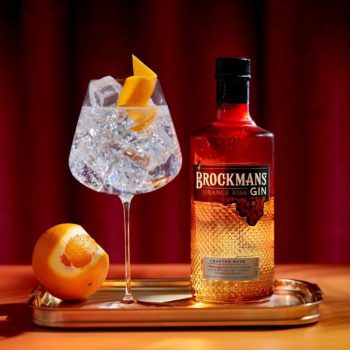
Eric Sampers, global marketing director of Brockmans Gin, says he was there for the start of the flavoured gin boom: “It was in 2018. I used to work at Beefeater, and we launched Beefeater Pink, which was the beginning for flavoured gins.” But Sampers notes that many people in the sector thought flavours would be a fad, and that big players have “played it a bit too deeply”, launching an onslaught of flavour variations. “People have sort of lost interest in trying all the colours of the rainbow,” he adds.
Brockmans’ portfolio, on the other hand, is modest, having only released three expressions since its inception in 2008, with two coming in 2022: Orange Kiss, a Valencia orange-flavoured gin that adds triple sec to its production, and Agave Cut, which combines the brand’s London Dry with agave spirit. Sampers says these expressions don’t behave like regular flavoured gins. “After Gordon’s and Beefeater, there’s not much room for colourful flavours,” he says. “That doesn’t mean you cannot innovate in gin and look at flavours, but you need to be careful with what you are doing. Agave Cut, he says, isn’t part of the gin craze. “It’s a crossover product between two categories, and two very dynamic ones at that.” The approach at Brockmans isn’t to launch as many products as it can, but to give consumers something unique. “That’s the DNA of the brand,” he says.
Jon Hillgren, founder and master distiller of Sweden’s Hernö Gin, says he has never been into flavoured gin, but does see a decline in the segment. “We do hardcore gins, and we try to keep to the heritage of what gin is,” he says. “Basically, all gins are flavoured, but what you’re talking about are actually gins that are sweetened or coloured. Hernö does a pink-style gin, but without the colours. The label is pink, but it’s taking the piss out of the industry a bit. Trends-wise you can see less space for flavoured gins, especially in our local market. Even though we are lagging behind big markets because we have a monopoly, it’s peaked over here as well. Most brands are struggling – it’s a tough world out there.”
Sweden is Hernö’s main market, but it also focuses on the rest of the Nordics, travel retail and the UK. Hillgren continues: “The UK is a tough market, and in the last years there were probably more gin brands closing down than opening up. Tequila and mezcal are also gaining more attention now.”
Noting that “bars no longer need 200 gins on their shelves, and are reducing their numbers”, Hillgren sees that people are going back to gins they prefer. “It’s not the same thing where you have to release so many SKUs, people are actually choosing their favourite gins. The loyalty is getting better, I would say.” This helps the older brands that have been around for a while. “For us as producers, we will stick to what gin is,” he says.
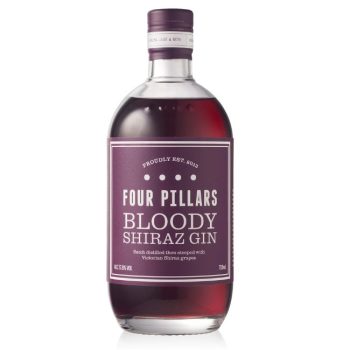
Having a loyal customer base and a clear point of difference has kept Australia’s Four Pillars’ flavoured gin production going strong. Self-described as “Australia’s best flavoured gin”, the brand’s home market has a soft spot for flavoured varieties, especially with localised ingredients like wine, which Four Pillars specialises in. Sarah Prowse, the brand’s new head of production and distilling, says the Australian market “loves our flavoured gin; they find it really quirky. It’s something a bit different and I think – maybe it’s just an Australian palate – they do well because they have a unique profile to them.”
Prowse says the brand’s biggest sellers are its Bloody Shiraz and Bloody Pinot Noir gins. “By September, they’re gone, so grape varieties are huge for us,” she says. Furthermore, limited edition releases like the annual Christmas gin, which has a “cult following”, have resonated with consumers too. The gin is distilled with ingredients inspired by the Christmas pudding recipe of co-founder Cameron Mackenzie’s late mother, Wilma – with mixed peel, sultanas, currants, and nutmeg – and 2024’s edition has already sold out. Prowse confided that she’s spoken with the team about the possibility of trying to make more to keep up with demand. “If you asked me two months ago, would I think that our Christmas gin would have sold out in weeks, I would have gone, ‘not in 100 years’,” she says. “I can’t work people out at the moment. I mean, it’s amazing and super exciting for us, but it’s really hard to predict what’s happening at the moment. I think people are just looking for something different. They just want to try the new thing.”
Halewood Artisanal Spirits insists it is pleased with its flavoured gin performance, but that it will be exercising restraint launching new flavours compared with previous years. The UK-headquartered company looks after Whitley Neill, which, according to IWSR data, is the biggest international premium flavoured gin brand, with about 10% market share globally, and about three times larger than number two – Tanqueray. Marketing and sales director James Stocker admits “we are in a tough moment”, and that the gin market has “declined since it reached its heady heights of three years ago”, but he insists Whitley Neill is holding up well. “Looking at Nielsen data, 52 weeks to the week ending 7 September, premium-plus flavoured gins are down by 18% in terms of sales value, and we’re only down 9%, just about touching 10%, so we’re growing share, which is positive,” he says.
Stocker adds: “We’re seeing the signs of the decline slowing, which is good, but it’s probably slowing faster with the unflavoured kind, which is obviously largely London Dry.”
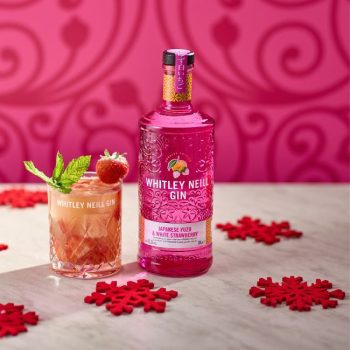
Whitley Neill is a London Dry at heart. Distiller’s Cut has been its flagship expression since the brand launched 20 years ago, but it’s also become known for flavours. Its range contains variants such Rhubarb & Ginger, Blood Orange, Pink Grapefruit, and Japanese Yuzu & White Strawberry. Rhubarb & Ginger is the top-selling flavour and the second is Raspberry, but Stocker identifies that we are seeing a “trend of all things Japanese at the moment”, which opens a new area of opportunity for flavours. The brand’s Yuzu & White Strawberry flavour’s success has seen it become the number-two contributor to growth in the premium gin category, he says, adding: “We’ve got five of our flavours in the top 10 in terms of growth in the category.”
While Stocker observes there is potential growth with umami flavours – a limited edition smoky bacon and horseradish flavour saw the brand dabble with this profile – he affirms: “Sweeter, Japanese-orientated things seem to be hitting the spot.”
Leaning into this trend, Whitley Neill also has Japanese-inspired Mandarin and Persimmon flavour in the pipeline. New product development will lessen, though, compared with the brand’s output during the flavour peak.
Stocker explains: “We’re not launching as many new flavours as we were three or four years ago. I don’t see the market can take it anymore, we’re launching flavours a little bit less frequently. But the good thing is when we do, they do seem to be successful.”
Difficult to grow
Adam Rogers, research director for North America, IWSR, feels “flavoured gin is heavily weighted down by standard and below-priced offerings, making it difficult to achieve overall growth”, particularly in the US.
To keep consumers engaged, he thinks limited edition offerings are good for brands. “This year Tanqueray has launched Paradiso, a tropical flavour-forward summer-style gin with Brazilian guava and hints of lemongrass. Roku has also launched Roku Sakura Bloom Edition, and Hendrick’s launched a limited edition flavoured gin, Neptunia.”
At La Martiniquaise-Bardinet, which oversees production of Generous Gin and Gibson’s Gin (both of which have flavours in their portfolios), Maéva Fonsino, international senior brand manager, also thinks fruit-forward gins could also find success from opting for less common ingredients, “such as mango, lychee, or even bolder combinations with spices could be deployed more strongly in the coming years”.
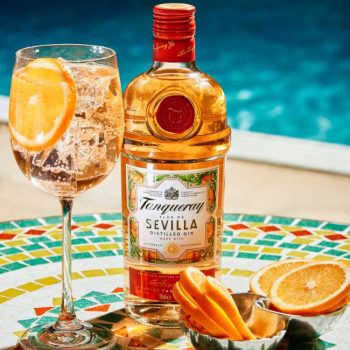
Flavours are also able to latch onto the low-and-no movement. At times, naysayers might find fault in low-ABV and alcohol-free serves for lacking in flavour. But Patricia Borges, global managing director of gin and rum at Diageo, believes moderation doesn’t mean needing to compromise on flavour or taste. This is where alcohol-free flavoured gin alternatives come in. “You would have seen the launch of Tanqueray Sevilla, which also has a popular alcohol-free variant offering the same experience for consumers choosing not to drink alcohol, without compromising on taste,” she says.
“When we align flavoured gins with moderation, we know that flavour helps to overcome one of the barriers of alcohol-free trial – taste.”
Borges adds: “Consumers can be sceptical about alcohol-free ‘spirits’ as they can’t imagine what they will taste like, but flavoured alcohol-free ‘gins’ negate this issue, and can overcome one of the reasons we see people hesitate when it comes to purchase.”
Life left in the trend
Having a unique proposition, thinking outside the box for ingredients, and keeping consumers on their toes with limited releases shows there’s still life left in the flavour trend yet. “It’s swings and roundabouts,” for the category, as Prowse puts it. Stocker agrees about the flavour downtrend: “The category still has plenty to it and, hopefully, we’ve seen the worst of it.”
What will be the next big trend in gin?
Polona Preskar – sales and marketing director, Broken Bones
“The huge distilleries will continue as they do, with launches and diversification. The core of sales will still be the London Dry gin, the rest will be mainly for marketing. Smaller distilleries will be consolidated rather than closed. So the offer of one distillery will be enlarged by the products of the other. The contemporary, artisan gin sector is going to be growing.”
Adam von Gootkin – founder and CEO, Highclere Castle Gin
“Gin will continue to shine in the on-trade as it eats into vodka market share. Flavour line extensions, which are saturated in the UK, will trend upwards in the US as consumers continue to explore gin over vodka.”
Ryan McFarland – chief commercial and strategy officer, Drinksology Kirker Greer
“There will always be a place for classic gins, but the future increasingly belongs to brands embracing a wider world of botanicals and adventurous taste sensations. Global influences, particularly Asian, are increasingly important, so expect to see Asian gins blossoming due to their adaptability and compatibility alongside popular Asian flavours.”
Marcin Czajkiewicz – co-owner, Heritage Gin
“We’ll see more craft brands, as consumers are looking for something truly unique, experimental, local, and high-quality. This leads to the use of rare, hyper-local, and specific ingredients, such as indigenous plants, fruits, or foraged botanicals, often inspired by local cuisine.”
Damola Timeyin – co-founder, Spearhead Spirits
“The world is big, but the stories told in gin come from a small range of places, until now. ‘Unexpected provenance’ will be the next gin trend. Expect provenance stories from Africa, with Bayab Gin and Procera, and the Mediterranean from the likes of Stray Dog gin.”
Jim Nash – director and co-founder, Wild Atlantic Distillery
“A focus on premium, craft gins made by sustainable distilleries with real stories, that have a strong local identity. We use only the best-quality ingredients (eg seaweed, hand-harvested by the Talty family in County Clare, who have been a family business for over 100 years) meeting consumers’ demand for authenticity. Consumers want to know the people behind the spirit, making the whole experience more personal, and involving them in the development and growth of our family distillery.”
Myriam Hendrickx – master distiller, De Kuyper Royal Distillers
“Sustainability. At Rutte we have joined this movement by distilling organic botanicals. Then there are also new and modern flavours like special citrus fruits or blossoms. We have also joined this trend with our Rutte Kaffir Lime gin (exclusively available in the Netherlands).”
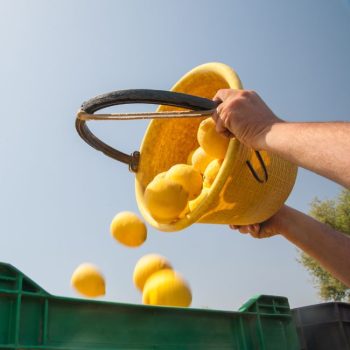 Patricia Borges – global managing director of gin and rum, Diageo
Patricia Borges – global managing director of gin and rum, Diageo
“There are two key trends that we see driving change in the gin category; the first is an increased desire to experiment with new products and innovations, while the second is an ongoing desire to moderate consumption with no-and-low products. We’ve seen consumers embrace RTDs [ready-to-drink], with 16% of consumers in the top 10 markets being new entrants to the category. We recently launched the Cocktail Collection, which offers consumers both an elevated experience and convenience in a single drink, with the likes of the Tanqueray Negroni. In terms of moderation, we’ve seen a change in the way people choose to moderate, with 36% of drinkers pacing their consumption with soft drinks throughout the same occasion. Gordon’s recently launched a campaign called ‘Mix It Up’, to demonstrate that moderation doesn’t have to be a binary decision, and empowers people to switch between alcohol and alcohol-free ‘gin’ options in a way that suits them, demonstrating that moderation doesn’t mean compromising on flavour or taste.”
Maéva Fonsino – international senior brand manager, La Martiniquaise-Bardinet
“Gins infused with medicinal plants or more herbal flavours (for example lavender or chamomile) are riding the wellbeing trend. These gins can be seen as more natural alternatives to traditional gins. We have also seen the rise of artisanal gins using local plants. We also believe in a trend that continues to prove its worth, which is barrel-aged gins. The aim is to bring more complex, woody/spicy notes to the gin. This trend could become more widespread, creating a new category of high-end gins. If we look a little further ahead, and thanks to the evolution of technology, the use of artificial intelligence could revolutionise gin creation and push the boundaries of personalisation. Artificial intelligence may then be able to analyse consumer data and social trends to predict future demand for certain types of gin.”
Imogen Armstrong – director, The Secret Garden Distillery
“Customers value sustainability, but price is becoming the main decision factor. Despite efforts to build brand advocates, larger brands’ pricing dominance is affecting market placement and influencing future trends.”
Sébastien Cliche-Roy – founder, Spiritueux
“I see the next big trend as the fusion of classic profiles with unexpected, exotic flavors. Think cucumber paired with the vibrant twist of yuzu – blending tradition with innovation to captivate both adventurous palates and fans of timeless gin sophistication.”
Tommy Jonasson – co-founder, Revsunds
“I think the gin business will do or is doing something like a craft beer revolution since there are a lot of breweries and distilleries like ourselves that originate from craft beer. Distillery collaborations, working with famous people, local botanicals, and ready-to-drink products with not only gin and tonic in them. Some will love it and some will hate it. I also think there are a lot of producers that will have a struggle to survive higher costs. It’s a competitive business that’s growing rapidly.”
Arno Schmid-Egger – managing director, Perola Fine Spirits, Germany and Singapore
“With the ongoing consolidation in the gin market, only gins with a distinct USP – strong brand identity and unique flavour profile – are likely to prevail.”
Patrick Halbert and Andrew Gill – CEO and chief strategy officer, Gin & Juice By Dre and Snoop
“We think 2025 is going to be a transformative year for gin, especially in the US. From the super-premium sector to flavoured spirits, we’re seeing some cool innovation and nostalgia sparking curiosity about this once-dominant spirit among a new generation, and those being reintroduced to the sector. Interestingly, we’re discovering that many people who previously considered themselves ‘non-gin drinkers’ are becoming enthusiastic converts after experiencing contemporary gin expressions like ours. Even our canned product, Gin & Juice, allowed us to experiment with unique flavours that weren’t commonly seen like apricot and passion fruit.”
Related news
Mataroa Gin features at Roma Bar Show
